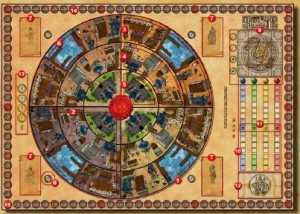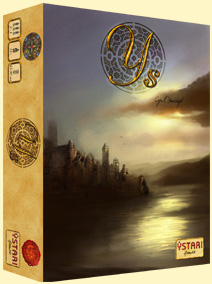Review: Ys
Posted by James (admin) on October 4th, 2010
 Ys is an area control game where players gain gems and points by placing their pieces in different areas of the city. It’s a fairly simple game but with some clever subtleties and interwoven game mechanics that make it stand out. I usually split out the game description from my opinion but I’ll look at each one as I explain them on this occasion
Ys is an area control game where players gain gems and points by placing their pieces in different areas of the city. It’s a fairly simple game but with some clever subtleties and interwoven game mechanics that make it stand out. I usually split out the game description from my opinion but I’ll look at each one as I explain them on this occasion
Hidden Value Piece Placement
Each player has a set of wooden cylinders in their colour which have a value on one end from between 0 to 4. During the game, players take turns placing two of their pieces into any of the 3 areas in any of the city’s 4 neighbourhoods, or onto the market grid. An interesting game mechanic is that one of the two placed pieces is placed with the number showing (numbered end face-up) and the other piece is placed with the number hidden (numbered end face-down). This means that players have some knowledge of what the competition in each area might be but not exact knowledge. I found this created really interesting gameplay as it allows for a bit of bluffing as well as posturing.
End of Round Gains
At the end of each round, the face-down pieces are all turned face-up. The players with the highest totals in a neighbourhood (all 3 areas in a neighbourhood combined) will receive gems. The gems available in each neighbourhood are decided by cards at the start of each round. Then, each area in a neighbourhood is assessed and the player with the highest total receives benefits depending upon the area (black gems worth points at game end, instant points and special abilities).
The market grid is an interesting game mechanic. It is 4 columns wide (one for each colour of gem) and the number of rows depends upon the number of players. Having the highest total in a market grid row will win a player a gem. The totals in the 4 columns determine what happens to the value of each colour of gems – for example, if the red column has the highest total then the value of the red gems will go up by 2 places. The values of the gems at the end of the game will affect how many points players will win for owning gems.
A good placement game should have you feeling like you have plenty of pieces to place but never enough to cover all the places where you want to place them. This means you have to make critical decisions on how to get the best from your actions. Ys does a great job of this, plus there are lots of ways in which you can combine your pieces to try and make gains – do you focus on winning city neighbourhoods for gems, for are benefits, or maybe you should try to manipulate the market to better suit the gems you already have. Of course, you need to do it all within the ever changing landscape of your opponent’s performance and actions.
 Turn Order, Splitting Ties and The King’s Favour
Turn Order, Splitting Ties and The King’s Favour
To add an extra element to the game, turn order is decided at the start of each round by players playing two of their pieces simultaneously and the highest total chooses which place in the turn order they want; however, these pieces are now used for the round. So, playing two high valued pieces means you’ll probably get your choice of turn order but means you don’t have those pieces to use during the round.
At the end of a round, each player will have one piece remaining and this is added to the pieces the player used when bidding for turn order. The total of the these 3 pieces will be used to split ties when evaluating areas. Deciding which pieces to use for turn order is very important and having a high total at the end of a round so you can win ties against other players can be critical.
Also, at the end of each round, players place one piece face-down in the King’s Favour box and receive one new piece of value 2. The players get points at the end of the game based on the value of pieces in the box. Like turn order, the player must choose whether they should commit high value pieces into the box to win the most points against the cost of not having those pieces to use during the rounds. The King’s Favour system means that each player’s set of pieces starts to differ as the game progresses.
Scoring
At the end of the game, each player scores points for having gems in each colour. The amount of points scored is based on the market value of the gem and how many a player has compared to the other players. For example, the player with the most gems of the most valuable colour (according to the market) scores 24 points, the player with the 2nd most scores 18 points, 3rd most scores 12 points, and 4th most scores 6 points. Players with gems in the second most valuable gem score 20, 15, 10 and 5 points. Gems of all 4 colours are scored.
This scoring system means it’s important to take an interest in (and manipulate) the market as well as working out which gems to collect and watching what gems other players have collected – especially as collected gems are kept hidden. If you can’t get gems of a colur, make them worth less so other players score fewer points. I like that it’s not based purely on the number of gems you collect (i.e. 6 points per gem for the highest value gem colour) as this means what you collect is important and not just the sheer numbers.
After scoring the gems, black gems score points purely based on the number you own – the more you own, the more they’re worth. Plus, the King’s Favour gets scored too.
Overall
I really enjoyed Ys. It’s actually quite simple but the cleverly interwoven game mechanics mean players must balance the use of their pieces, work out the ways to get the most out of their placement and respond to their opponents’ actions. Also, collecting gems is very important but you need to keep an eye on (or preferably an active involvement in) the market so your gems will be worth the most points and your opponents’ worth less.
I like area control games and worker placement and this mixed the two together very nicely. With the placement of pieces, the game has a high level of interaction and very little downtime. I don’t own a copy of Ys but I expect I shall pick one up soon.
James.
[Played with 3 players]

